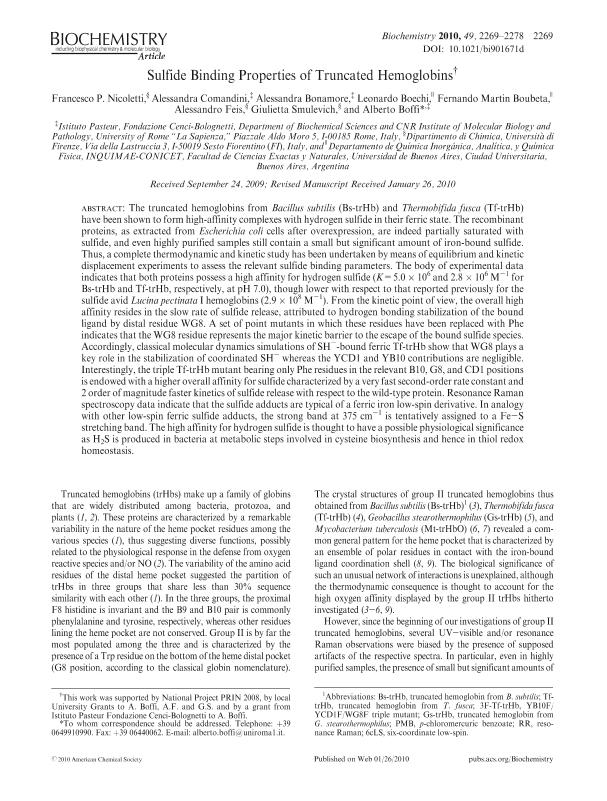Mostrar el registro sencillo del ítem
dc.contributor.author
Nicoletti, Francesco P.
dc.contributor.author
Comandini, Alessandra
dc.contributor.author
Bonamore, Alessandra
dc.contributor.author
Boechi, Leonardo

dc.contributor.author
Boubeta, Fernando Martín

dc.contributor.author
Feis, Alessandro
dc.contributor.author
Smulevich, Iulietta
dc.contributor.author
Boffi, Alberto
dc.date.available
2019-03-19T16:20:03Z
dc.date.issued
2010-03
dc.identifier.citation
Nicoletti, Francesco P.; Comandini, Alessandra; Bonamore, Alessandra; Boechi, Leonardo; Boubeta, Fernando Martín; et al.; Sulfide binding properties of truncated hemoglobins; American Chemical Society; Biochemistry; 49; 10; 3-2010; 2269-2278
dc.identifier.issn
0006-2960
dc.identifier.uri
http://hdl.handle.net/11336/72014
dc.description.abstract
The truncated hemoglobins from Bacillus subtilis (Bs-trHb) and Thermobifida fusca (Tf-trHb) have been shown to form high-affinity complexes with hydrogen sulfide in their ferric state. The recombinant proteins, as extracted, from Escherichia coli cells after overexpression, are indeed partially saturated with sulfide, and even highly purified samples still contain a small but significant amount of iron-bound sulfide. Thus, a complete thermodynamic and kinetic study has been undertaken by means of equilibrium and kinetic displacement experiments to assess the relevant sulfide binding parameters. The body of experimental data indicates that both proteins possess a high, affinity for hydrogen sulfide (K= 5.0 × 106 and 28 × 106 M-1 for Bs-trHb and Tf-trHb, respectively, at pH 7.0), though, lower with, respect to that reported previously for the sulfide avid Lucina pectinata I hemoglobins (2.9 × 108 M-1). From the kinetic point of view, the overall high affinity resides in the slow rate of sulfide release, attributed to hydrogen bonding stabilization of the bound ligand by distal residue WG8. A set of point mutants in which these residues have been replaced with Phe indicates that the WG8 residue represents the major kinetic barrier to the escape of the bound sulfide species. Accordingly, classical molecular dynamics simulations of SH.....-bound ferric Tf-trHb show that WG8 plays a key role in the stabilization of coordinated SH -whereas the YCD1 and. YB10 contributions are negligible. Interestingly, the triple Tf-trHb mutant bearing only Phe residues in the relevant B10, G8, and CD1 positions is endowed with a higher overall affinity for sulfide characterized, by a very fast second-order rate constant and 2 order of magnitude faster kinetics of sulfide release with respect to the wild-type protein. Resonance Raman spectroscopy data indicate that the sulfide adducts are typical of a ferric iron, low-spin derivative. In analogy with other low-spin ferric sulfide adducts, the strong band at 375 cm-1 is tentatively assigned to a Fe-S stretching band. The high affinity for hydrogen, sulfide is thought to have a possible physiological significance as H2S is produced in bacteria at metabolic steps involved in cysteine biosynthesis and hence in thiol redox homeostasis. © 2010 American Chemical Society.
dc.format
application/pdf
dc.language.iso
eng
dc.publisher
American Chemical Society

dc.rights
info:eu-repo/semantics/openAccess
dc.rights.uri
https://creativecommons.org/licenses/by-nc-sa/2.5/ar/
dc.subject
Sulfide-Binding
dc.subject
Simulation
dc.subject
Truncated-Hemoglobin
dc.subject.classification
Otras Ciencias Químicas

dc.subject.classification
Ciencias Químicas

dc.subject.classification
CIENCIAS NATURALES Y EXACTAS

dc.title
Sulfide binding properties of truncated hemoglobins
dc.type
info:eu-repo/semantics/article
dc.type
info:ar-repo/semantics/artículo
dc.type
info:eu-repo/semantics/publishedVersion
dc.date.updated
2019-03-08T20:30:38Z
dc.journal.volume
49
dc.journal.number
10
dc.journal.pagination
2269-2278
dc.journal.pais
Estados Unidos

dc.journal.ciudad
Washington
dc.description.fil
Fil: Nicoletti, Francesco P.. Università degli Studi di Firenze; Italia
dc.description.fil
Fil: Comandini, Alessandra. Università degli studi di Roma "La Sapienza"; Italia
dc.description.fil
Fil: Bonamore, Alessandra. Università degli studi di Roma "La Sapienza"; Italia
dc.description.fil
Fil: Boechi, Leonardo. Consejo Nacional de Investigaciones Científicas y Técnicas. Oficina de Coordinación Administrativa Ciudad Universitaria. Instituto de Química, Física de los Materiales, Medioambiente y Energía. Universidad de Buenos Aires. Facultad de Ciencias Exactas y Naturales. Instituto de Química, Física de los Materiales, Medioambiente y Energía; Argentina. Universidad de Buenos Aires. Facultad de Ciencias Exactas y Naturales. Departamento de Química Inorgánica, Analítica y Química Física; Argentina
dc.description.fil
Fil: Boubeta, Fernando Martín. Consejo Nacional de Investigaciones Científicas y Técnicas. Oficina de Coordinación Administrativa Ciudad Universitaria. Instituto de Química, Física de los Materiales, Medioambiente y Energía. Universidad de Buenos Aires. Facultad de Ciencias Exactas y Naturales. Instituto de Química, Física de los Materiales, Medioambiente y Energía; Argentina. Universidad de Buenos Aires. Facultad de Ciencias Exactas y Naturales. Departamento de Química Inorgánica, Analítica y Química Física; Argentina
dc.description.fil
Fil: Feis, Alessandro. Università degli Studi di Firenze; Italia
dc.description.fil
Fil: Smulevich, Iulietta. Università degli Studi di Firenze; Italia
dc.description.fil
Fil: Boffi, Alberto. Università degli studi di Roma "La Sapienza"; Italia
dc.journal.title
Biochemistry

dc.relation.alternativeid
info:eu-repo/semantics/altIdentifier/doi/https://dx.doi.org/10.1021/bi901671d
dc.relation.alternativeid
info:eu-repo/semantics/altIdentifier/url/https://pubs.acs.org/doi/10.1021/bi901671d
Archivos asociados
